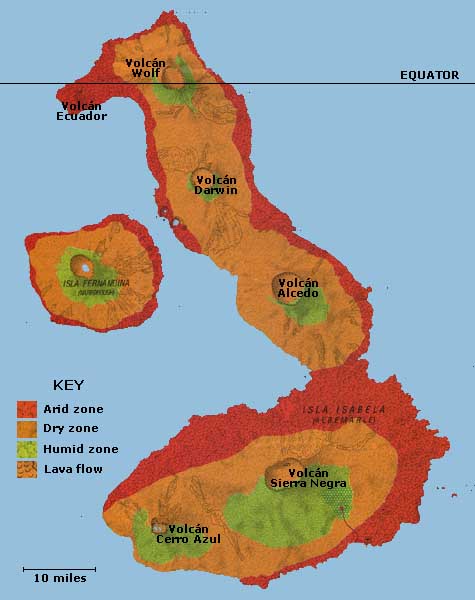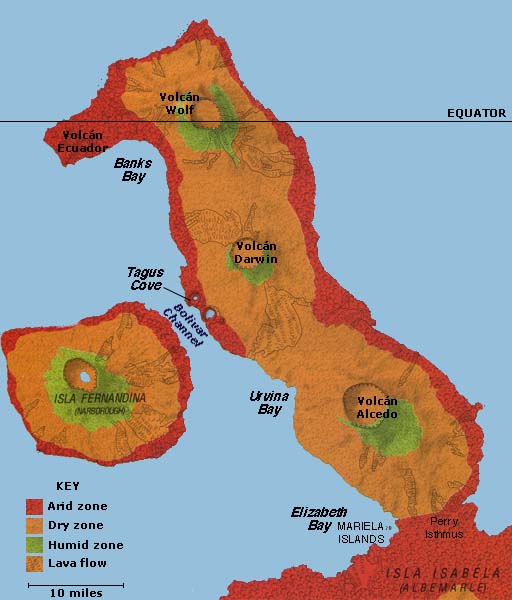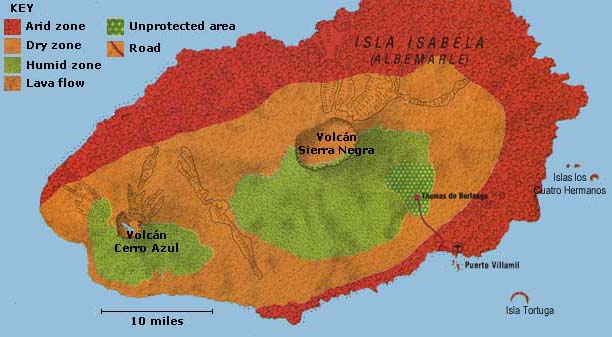ISABELA ISLAND MAP
Isabela Island is by far the biggest island of the Galapagos—bigger than all the other islands combined. It is
about 75 miles long and 50 miles at its widest. The total land area is 1771 square miles—bigger than Rhode
Island. It is comprised five major volcanoes, of which two are still active. These mountains were probably separate
at one time and then fused in to a single mass. The most recent eruption was Cerro Azul in 1999. So the island is
still rising, and Wolf Volcano is the highest point in the islands—an elevation of 5,600 feet. Its name comes
from Queen Isabela of Spain (1451-1504) who helped Columbus get money for his voyages in the 1490s. On older maps
you will see it called Albelmarle, named by the English after a duke. To better show important features the map has
been split into a northern and southern half. |
Click below to see the Isabela Island maps and information:
Isabela Island
northern Isabela
southern Isabela
ISABELA ISLAND
Click image to return to gallery
This map shows the entire island of Isabela. For more information about the island, scroll down to the maps of northern and southern Isabela. |
NORTHERN ISABELA
Click image to return to gallery
The northern part of Isabela is wild, remote, even forbidding. The main feature is the line of volcanoes that lie in a northwest direction. It is easy to see how the island is formed from these huge mountains fused together. Volcan Alcedo is the second largest volcano on Isabela and was once popular for visitors to climb up. However, a recent program to eliminate the tens of thousands of wild goats that plague the area has left huge numbers of carcasses on the slopes and so visitors are no longer permitted on Alcedo. Volcan Darwin was named to honor Charles Darwin, the Galapagos' most famous visitor. The equator runs through the caldera of Volcan Wolf which is named after an Ecuadorian geologist. Sailing around Volcan Ecuador you can see that half the volcano has slipped into the ocean—what a cataclysmic event that must have been! Scientists figured out that it caused a huge tidal wave. The Bolivar Channel, between Fernandina and Isabela, is among the best places in the islands for whale watching. Here, the waters are relatively shallow and upwelling brings nutrients from deeper waters, so the channel is rich in plankton. (See additional information page to learn about the Visitor Sites.) |
SOUTHERN ISABELA
Click image to return to gallery
Volcan Sierra Negra is the dominant feature of Isabela's southern half. This huge mountain has the world's second largest caldera (crater) after Ngorogoro in Africa. It measures about 6 miles wide by 4.5 miles across. Puerto Villamil is the main settlement on the island, with about 1,000 people. A dirt road leads from here to Thomas de Berlanga, a small farming community. Visitors can take a horse ride up to the caldera around to the northeast of the crater. Here are large fumaroles—outlets from the volcano that emit steam and sulfurous gases. From here is a spectacular view of the entire island, and beyond to Santiago (James) Island. Volcan Cerro Azul is the smallest volcano on Isabela, but also the most active. It erupted for several weeks late 1999, threatening several populations of giant tortoises that were airlifted to safety at the research center in Puerto Villamil. |
Learn more about Isabela Island and Visitor Sites
next map
|



